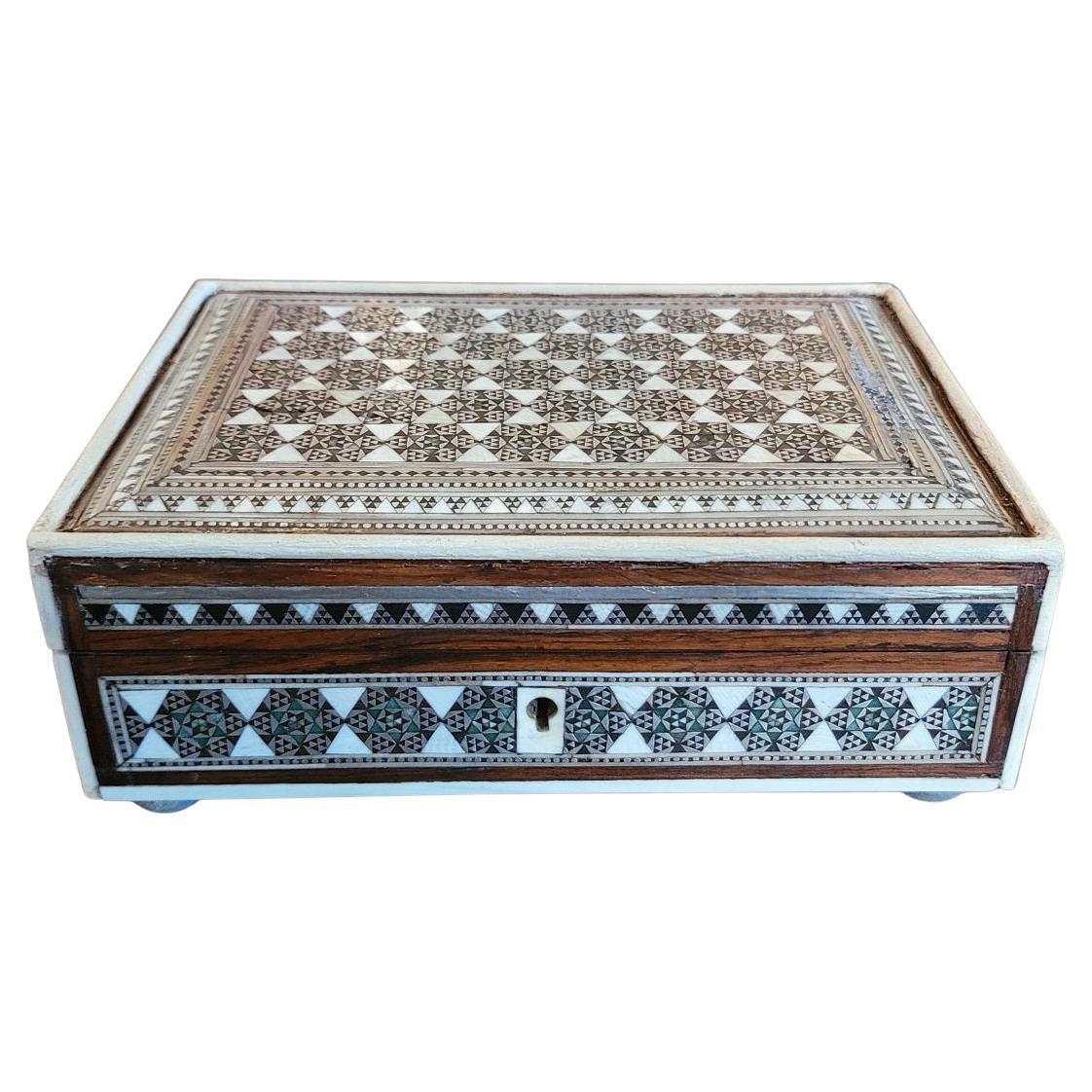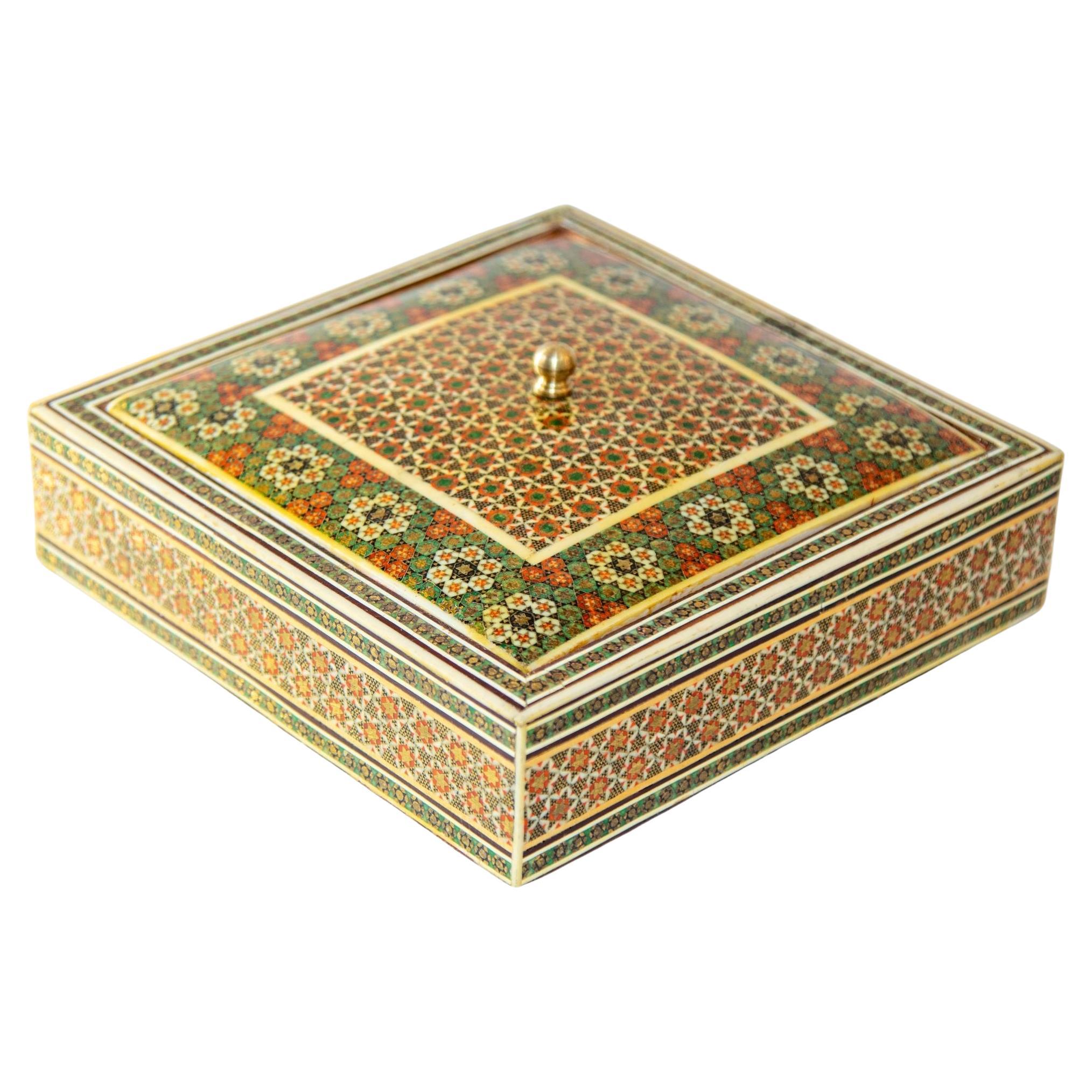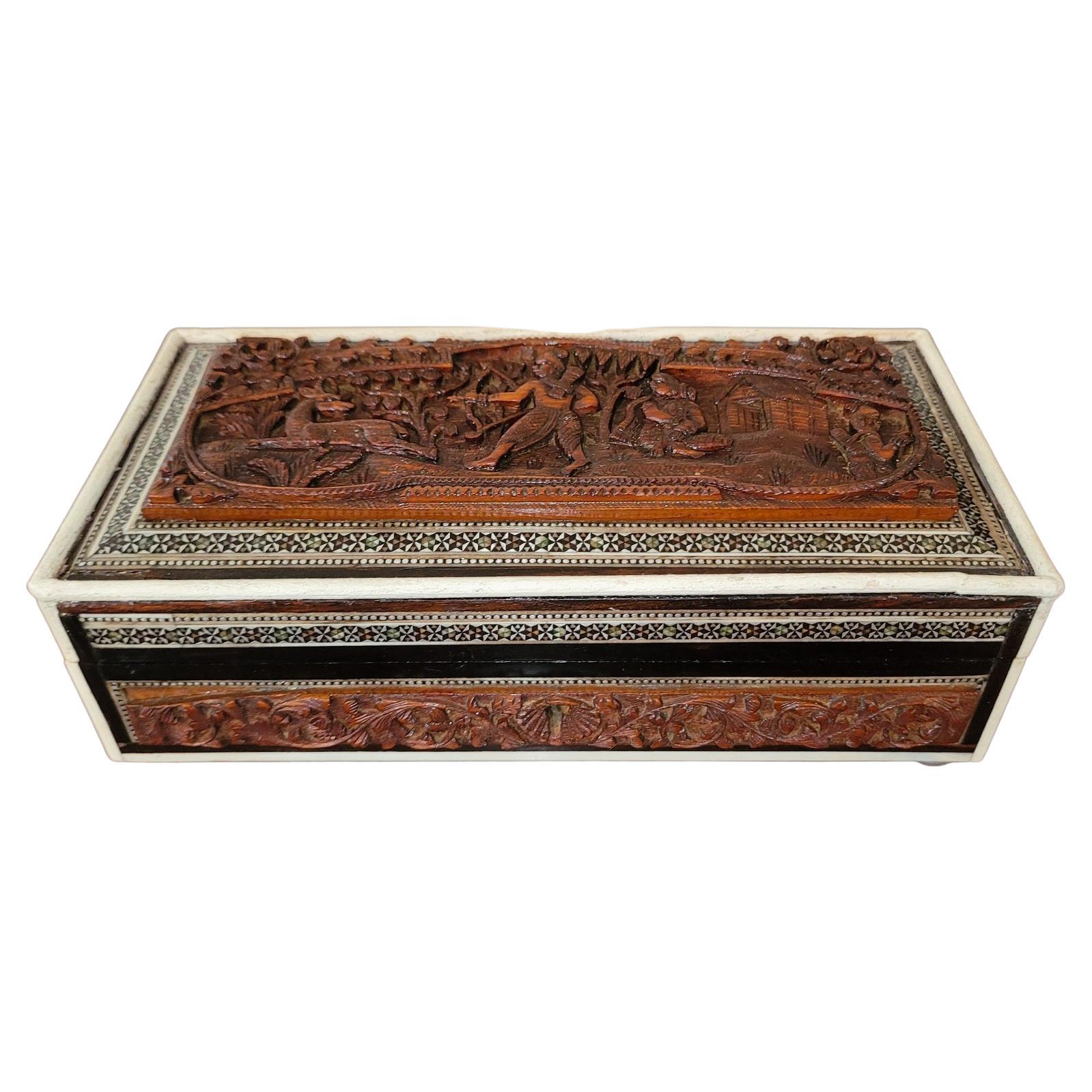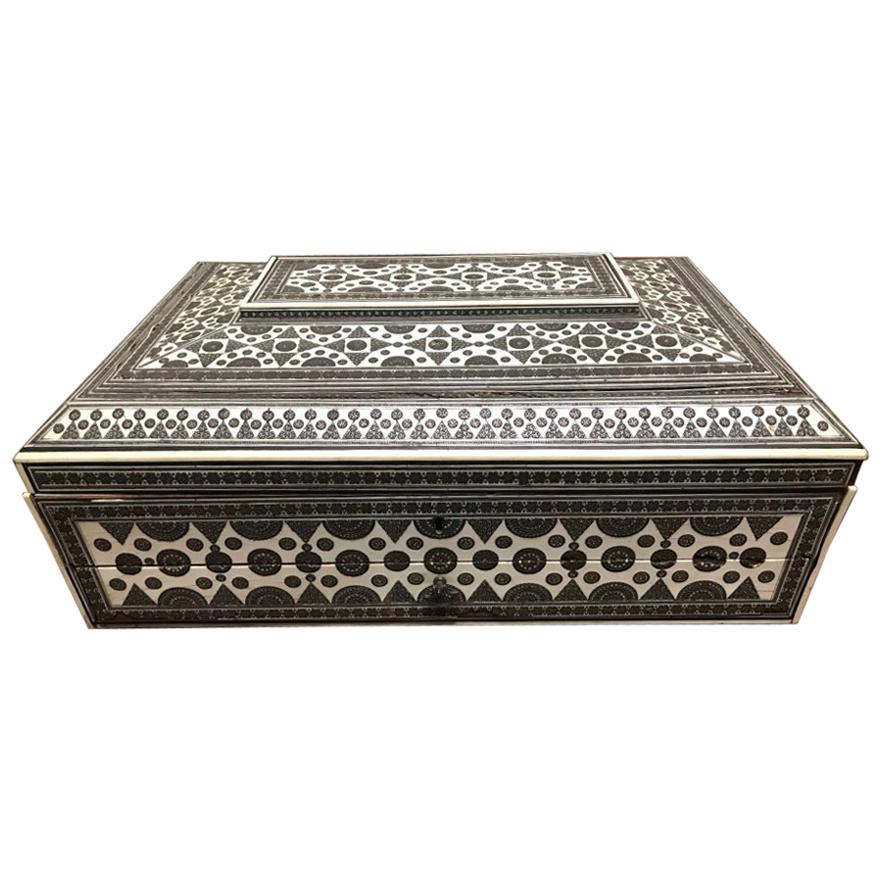Items Similar to 19th Century Anglo-Indian Sadeli Mosaic Jewelry Box with Lidded Compartments
Want more images or videos?
Request additional images or videos from the seller
1 of 20
19th Century Anglo-Indian Sadeli Mosaic Jewelry Box with Lidded Compartments
About the Item
19th century Anglo-Indian sandal wood box, Sadeli mosaic box fitted with various compartments finely hand-carved with the Taj Mahal.
Of sarcophagus form with carved and inlaid decoration, the interior with a compartmentalized and lidded tray.
The interior with removable hand-carved eight-lidded compartments, the front cover has a mirror, the whole exhibiting very fine workmanship.
This fine late victorian Anglo Indian Sadeli micro mosaic jewelry box from India is in great condition for it age, some Sadeli mosaic missing on top corner.
A beautiful example of an Anglo Indian Bombay Sadeli Box, having geometric mosaic decoration raised on squat bun feet and lined in plush velvet, with lock and key.
The ancient art of Sadeli Mosaic is said to have been introduced from Shiraz in Persia via Sind to Bombay, a long time before the Anglo Indian boxes were made. It was a technique, which required a high degree of skill and patience. It was executed very lavishly, in that the frequent cuts wasted a great amount of the precious materials used. The workmanship was however more than commensurable to the value of the materials.
A highly collectible example in superb condition complete
Wonderful condition throughout, Circa 1870.
Some missing inlay mosaic.
History of the Anglo-Indian Boxes
Beginning in the early part of the 18th century, Indian artisans made what came to be known as Anglo-Indian boxes for the English residents living in India, who eventually brought or sent them back to England. At the beginning of the 19th century, India began exporting these boxes commercially, although not in any significant numbers until the 1850s. People valued them so highly that manufacturers of tins copied the designs on them in the late 19th and early 20th century.
Anglo-Indian boxes in sandalwood boxes are covered with Sadeli mosaic.
From Vizagapatam in East India or from Bombay in West India.
English traders discovered the rich woods and intricate workmanship of Indian artisans, so colonial government officials began to recognize the work of the Indian artists and craftsmen as a source for satisfying the need for furniture and boxes, which would both serve to enhance English households in India. This gave rise to the cabinetmaking workshops in Vizagapatam between Calcutta and Madras.
Craftsmen made the first boxes to be decorated with Sadeli mosaic incised to give further definition to the decoration, directly inlaid into the wood. The shape of the early boxes was either sloping at the front with a flatter section at the back, reminiscent of English writing slopes, or rectangular. Artisans inlaid the borders with stylized floral scrolls and the centers with a single floral motif following a circular or oval symmetrical or asymmetrical pattern. The edging was of a combination of inlay and wood. Both ornamental and protective, both helped protect the end grain against the weather.
Made in Vizagapatam, situated on the south east coast of India, near Madras
Retailed in Madras and Calcutta by the English and Dutch East India Companies.
- Dimensions:Height: 3.5 in (8.89 cm)Width: 9 in (22.86 cm)Depth: 6.5 in (16.51 cm)
- Style:Anglo-Indian (In the Style Of)
- Materials and Techniques:
- Place of Origin:
- Period:
- Date of Manufacture:1870
- Condition:Wear consistent with age and use. Minor losses. some missing mosaic inlay.
- Seller Location:North Hollywood, CA
- Reference Number:
About the Seller
5.0
Platinum Seller
These expertly vetted sellers are 1stDibs' most experienced sellers and are rated highest by our customers.
1stDibs seller since 2011
2,622 sales on 1stDibs
Typical response time: 1 hour
- ShippingRetrieving quote...Ships From: North Hollywood, CA
- Return PolicyA return for this item may be initiated within 7 days of delivery.
More From This SellerView All
- Anglo-Indian Footed Box with Lidded Compartments, 19th CenturyLocated in North Hollywood, CA19th century Anglo-Indian wooden box fitted with various compartments finely hand carved. The top is finely hand carved with the Taj Mahal. The interior with removable hand carved nine-lidded compartments, the front cover has a mirror, the whole exhibiting very fine workmanship. This fine late Victorian Anglo-Indian box from India is in great condition for it age. A beautiful example of an Anglo-Indian fine art...Category
Antique Late 19th Century Indian Anglo-Indian Decorative Boxes
MaterialsSandalwood
- 1950s Anglo Indian Micro Sadeli Mosaic Inlaid Jewelry BoxLocated in North Hollywood, CA1950s Anglo Indian Micro Sadeli Mosaic Inlaid Jewelry Box. DIMENSIONS: 7ʺW × 7ʺD × 2.5ʺH. Indo Persian Moorish style micro mosaic inlaid jewelry box with lid. Intricate inlaid Anglo ...Category
Mid-20th Century Indian Moorish Decorative Boxes
MaterialsFruitwood, Bone
- Antique Anglo-Indian Vizagapatam Jewelry Inlaid Sadeli Footed BoxLocated in North Hollywood, CAAntique 19th century Anglo-Indian jewelry, trinket footed box, inlay with ebony, mosaic marquetry Sadeli work and a carved Hindu scene on top. The box case is made from sandalwood wi...Category
Early 20th Century Indian Anglo-Indian Decorative Boxes
MaterialsWood, Bone, Mother-of-Pearl
- Anglo Indian Micro Sadeli Mosaic Inlaid Hexagonal BoxLocated in North Hollywood, CAAnglo Indian Moorish style micro mosaic inlaid jewelry box with lid. Intricate inlaid Anglo Indian box with floral and geometric Moorish Sadeli design in an octagonal shape form with micro mosaic marquetry, very fine artwork. Museum collector piece like the one in Doris Duke Islamic Art Museum. The repeating geometric patterns of Sadeli Mosaic...Category
Early 20th Century Moorish Jewelry Boxes
MaterialsFruitwood
- 19th Century Anglo-Indian Mughal BoxLocated in North Hollywood, CA19th century Anglo-Indian Mughal wood box, inlaid and hand carved with the Taj Mahal and some flowers all around. Jewelry box, Anglo-Raj box from India in great condition. Nice Mughal Bombay Box...Category
Antique Late 19th Century Indian Anglo Raj Decorative Boxes
MaterialsSandalwood
- 1950s Anglo Indian Style Micro Mosaic Inlaid Jewelry BoxLocated in North Hollywood, CA1950's Anglo Indian, Indo Persian style micro mosaic inlaid jewelry box with lid. Large vintage intricate inlaid middle Eastern Persian style box with floral and geometric Islamic Mo...Category
Mid-20th Century Indian Anglo-Indian Decorative Boxes
MaterialsFruitwood
You May Also Like
- 19C Anglo Indian Bombay MOP Sadeli Mosaic Trinket BoxLocated in Dallas, TXPRESENTING a LOVELY 19C Anglo Indian Bombay MOP (Mother of Pearl) Sadeli Mosaic Trinket Box from circa 1875-85. Gorgeously detailed and hand-crafted ‘sadeli mosaic’ inlay, from the Bombay Area, with deep greens with silver, pewter, mother of pearl, bone and ebony in geometric patterns. The box case, is made of sandalwood but completely covered in MOP, bone, faux ivory, ebony and mosaic inlay. Edged with faux ivory and banded with a different pattern of sadeli mosaic. Some minor damage to the top (repair is obvious in pics) and ivorine replacements to some edging, but it still a BEAUTIFUL BOX and of real QUALITY! The mosaic work is FABULOUS! Box opens to reveal its original blue velvet lining. It sits on 4 (recently added) silvered button feet. SADELI MOSAIC: “Anglo Indian boxes were made in India for the English residents from the early part of the 18th century. They were brought back or sent back to England usually by the people who had commissioned them. From the beginning of the nineteenth century they were imported more commercially, although not in any significant numbers until the middle decades. They were very highly valued, especially the early ones, to the extent that the designs were copied on late 19th and early 20th century tins. The ancient art of Sadeli Mosaic is said to have been introduced from Shiraz in Persia via Sind to Bombay, a long time before the Anglo Indian boxes were made. It was a technique, which required a high degree of skill and patience. It was executed very lavishly, in that the frequent cuts wasted a great amount of the precious materials used. The workmanship was however more than commensurable to the value of the materials. Ivory, silver, pewter (or other metals), wood and horn were cut into faceted rods which were bound together to form geometric patterns. When the glue has set, the rods were sliced in transverse sections. This gave the maker a number of angled circular pieces in the original pattern. Several variations of patterns could be achieved by combining the materials in different ways. The ivory was sometimes dyed green to give an extra color. The mosaic pieces in a combination of patterns, often separated by ivory, ebony, horn or silver stringing were used to veneer sandalwood boxes. In the early boxes, which date from the turn of the 18th to the 19th century, there are large panels of mosaic covering tops and sides of boxes. It took incredible skill to cover such large areas without any shakes or wavering of the pattern. The corners and joins on these boxes are impeccably matched. The makers (reputed to be Persian) of Sadeli mosaic made in the first two decades of the 19th century displayed a total understanding of the qualities of the different materials they used. They combined substances, which can expand and contract according to atmospheric conditions with others, which are hard and unyielding. The result was a sharp definition of the lines and patterns, which made up the whole design. On the early boxes the designs look deceptively simple. The fact is, they emerged from a culture, which had mastered geometry and understood how to generate a pattern from a set number of points. The patterns are so harmoniously combined that their incredible complexity is not immediately apparent. The earliest Sadeli boxes...Category
Antique Late 19th Century Indian Anglo-Indian Jewelry Boxes
MaterialsSilver
- 19C Anglo Indian Carved Padouk Wood and Sadeli Mosaic BoxLocated in Dallas, TXPRESENTING A LOVELY 19th century Anglo-Indian Carved Padouk Wood and Sadeli Mosaic Box, featuring a carving of a Hunt Scene. Made circa 1870 in Bombay, India during the Rule of th...Category
Antique Late 19th Century Indian Anglo-Indian Jewelry Boxes
MaterialsSilver, Pewter
- 19C Anglo Indian Sadeli Mosaic Greeting Card CaseLocated in Dallas, TXPresenting a superb 19C Anglo Indian Sadeli Mosaic greeting card case. Made in or around Bombay, India circa 1880. This is a greeting card case used for holding your greeting cards or business cards of the day ! The body of the case is made from sandalwood and it is fully overlaid with bone and highly intricate Sadeli Mosaic made up of thousands of micro mosaic pieces of bone, ebony, silver/pewter and semi precious stone. The workmanship is stupenduous !!!! This case is almost museum quality. One or two very, very minor losses of mosaic mainly where the top meets the body but otherwise near mint ! SADELI MOSAIC: “Anglo Indian boxes were made in India for the English residents from the early part of the 18th century. They were brought back or sent back to England usually by the people who had commissioned them. From the beginning of the nineteenth century they were imported more commercially, although not in any significant numbers until the middle decades. They were very highly valued, especially the early ones, to the extent that the designs were copied on late 19th and early 20th century tins. The ancient art of Sadeli Mosaic is said to have been introduced from Shiraz in Persia via Sind to Bombay, a long time before the Anglo Indian boxes were made. It was a technique, which required a high degree of skill and patience. It was executed very lavishly, in that the frequent cuts wasted a great amount of the precious materials used. The workmanship was however more than commensurable to the value of the materials. Ivory, silver, pewter (or other metals), wood and horn were cut into faceted rods which were bound together to form geometric patterns. When the glue has set, the rods were sliced in transverse sections. This gave the maker a number of angled circular pieces in the original pattern. Several variations of patterns could be achieved by combining the materials in different ways. The ivory was sometimes dyed green to give an extra color. The mosaic pieces in a combination of patterns, often separated by ivory, ebony, horn or silver stringing were used to veneer sandalwood boxes. In the early boxes, which date from the turn of the 18th to the 19th century, there are large panels of mosaic covering tops and sides of boxes. It took incredible skill to cover such large areas without any shakes or wavering of the pattern. The corners and joins on these boxes are impeccably matched. The makers (reputed to be Persian) of Sadeli mosaic made in the first two decades of the 19th century displayed a total understanding of the qualities of the different materials they used. They combined substances, which can expand and contract according to atmospheric conditions with others, which are hard and unyielding. The result was a sharp definition of the lines and patterns, which made up the whole design. On the early boxes the designs look deceptively simple. The fact is, they emerged from a culture, which had mastered geometry and understood how to generate a pattern from a set number of points. The patterns are so harmoniously combined that their incredible complexity is not immediately apparent. The earliest Sadeli boxes...Category
Antique Late 19th Century Indian Anglo Raj Decorative Boxes
MaterialsBone, Precious Stone, Ebony
- 19th Century Anglo-Indian Sadeli Inlaid Work Box Traveling Writing DeskLocated in Stamford, CTA stunning camel bone, ebony and metal inlaid sadeli work box with portable writing desk, Bombay, circa 1850. The sandalwood body of faceted rec...Category
Antique Mid-19th Century Indian Anglo-Indian Decorative Boxes
MaterialsMetal
- 19C Anglo Indian Highly Carved Padouk Wood with Sadeli Mosaic Inlay Sewing BoxLocated in Dallas, TXPRESENTING A LOVELY 19C Anglo Indian Highly Carved Padouk Wood with Sadeli Mosaic Inlay Sewing Box. Made in Bombay, India, circa 1880. The box is made of sandalwood with highly carved raised padouk wood panels on all sides, depicting temple scenes, animals and foliage. The box is in a sarcophagus form. It is edged in bone (and we can tell it is bone and not ivory, from the color and evidence of capillaries, which are not found in ivory), and banded with Bombay Sadeli mosaic and ebony veneer. The lid opens to reveal a removable tray with various open compartments and lidded compartments. 5 lidded compartments, 1 unlidded compartment and 8 holders for thimbles, etc The tray lifts to reveal a blue velvet (original) lined section, for storing jewelry etc, with sections for collars etc. The inside of the lid has a removable mirror (the mirror is missing on this one but can easily be replaced). Behind the mirror is the original green velvet lining. It has its original brass carry handles on the sides and sits on 4 silvered button feet (of recent origin). Some repairs to the exterior and condition issues (priced accordingly), but still a LOVELY COLLECTIBLE box! These boxes were made by superb Indian craftsmen, specifically for sale to the ruling British elite. These types of boxes, carved padouk and sandalwood, (whilst beautiful and superbly crafted) were of a lesser quality, than the more profusely and intricately mosaic inlay, tortoiseshell and ivory boxes, made for the British ‘Upper Classes’ in the areas of Bombay and Vizagapatam. These type of boxes were much more affordable back in 1880 (and indeed today) and would probably have been bought by mid-level diplomats, civil servants or visitors. Sewing boxes (in general), were in EVERY Victorian home in Britain in the 19th century and like other boxes etc were ‘status symbols’ of your place in society! The more ornate the box, the more ‘Upper Class’ you were! SADELI MOSAIC: “Anglo Indian boxes were made in India for the English residents from the early part of the 18th century. They were brought back or sent back to England usually by the people who had commissioned them. From the beginning of the nineteenth century they were imported more commercially, although not in any significant numbers until the middle decades. They were very highly valued, especially the early ones, to the extent that the designs were copied on late 19th and early 20th century tins. The ancient art of Sadeli Mosaic is said to have been introduced from Shiraz in Persia via Sind to Bombay, a long time before the Anglo Indian boxes were made. It was a technique, which required a high degree of skill and patience. It was executed very lavishly, in that the frequent cuts wasted a great amount of the precious materials used. The workmanship was however more than commensurable to the value of the materials. Ivory, silver, pewter (or other metals), wood and Horn were cut into faceted rods which were bound together to form geometric patterns. When the glue has set, the rods were sliced in transverse sections. This gave the maker a number of angled circular pieces in the original pattern. Several variations of patterns could be achieved by combining the materials in different ways. The ivory was sometimes dyed green to give an extra color. The mosaic pieces in a combination of patterns, often separated by ivory, ebony, Horn or silver stringing were used to veneer sandalwood boxes. In the early boxes, which date from the turn of the 18th to the 19th century, there are large panels of mosaic covering tops and sides of boxes. It took incredible skill to cover such large areas without any shakes or wavering of the pattern. The corners and joins on these boxes are impeccably matched. The makers (reputed to be Persian) of Sadeli mosaic made in the first two decades of the 19th century displayed a total understanding of the qualities of the different materials they used. They combined substances, which can expand and contract according to atmospheric conditions with others, which are hard and unyielding. The result was a sharp definition of the lines and patterns, which made up the whole design. On the early boxes the designs look deceptively simple. The fact is, they emerged from a culture, which had mastered geometry and understood how to generate a pattern from a set number of points. The patterns are so harmoniously combined that their incredible complexity is not immediately apparent. The earliest Sadeli boxes...Category
Antique Late 19th Century Indian Anglo-Indian Decorative Boxes
MaterialsBone, Padouk, Sandalwood
- Anglo Indian Micro Mosaic Inlay Jewelry BoxLocated in New York, NYExquisitely crafted early 20th century Anglo Indian micro mosaic Sadeli box with gorgeous antique Persian geometric pattern. The finely detailed box featu...Category
Early 20th Century Indian Anglo-Indian Jewelry Boxes
MaterialsFruitwood, Bone
Recently Viewed
View AllMore Ways To Browse
Box With Lid
Boxes With Lids
Antique Box With Lid
Wood With Lid
Antique Indian Art
Indian Antique Art
Asia Jewelry
Asian Jewellery
Asian Jewlry
Asian Jewlery
19th Century Anglo Indian
18th Century Jewlery Box
Compartment Jewelry
Ancient Fine Art
Art Indian 19th Century
India Art And Jewelry
Tray With Lid
West Indian Furniture





